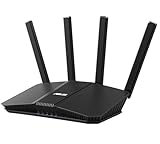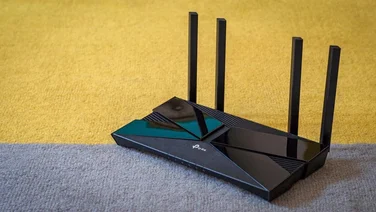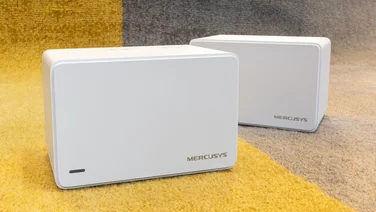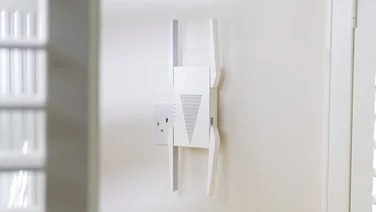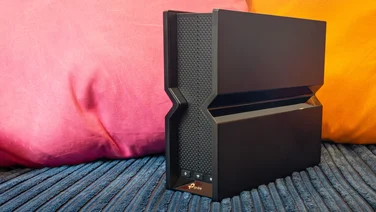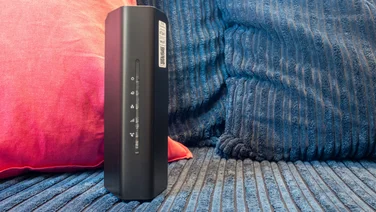To help us provide you with free impartial advice, we may earn a commission if you buy through links on our site. Learn more












- Cheaper than the cheapest rival
- More than fast enough for home use
- Amazingly versatile firmware
- Plenty of even faster alternatives
- Management can be fiddly
- No 6GHz radio
Wi-Fi 7 is becoming properly mainstream, with a reasonable number of routers now on the market at a wide range of price points. The Asus RT-BE58U is the first we’ve seen from this particular manufacturer, but it makes an immediate splash with an extraordinarily low price. In fact, at £110 it’s comfortably the cheapest Wi-Fi 7 router we’ve tested.
For that price, you don’t get a top-tier specification, but it’s a bona fide Wi-Fi 7 router with enough performance for almost any home, and a huge set of features and advanced management options.
To be honest, that might be a double-edged sword. If you’re looking for cheap, plug-and-play Wi-Fi 7, the almost-as-cheap Netgear Nighthawk RS100 might be easier to get along with. In terms of bang for buck, though, the Asus is an unbeatable deal.
Asus RT-BE58U Wi-Fi 7 router review: What you need to know
The RT-BE58U is a dual-band Wi-Fi 7 router; in other words, it supports 2.4GHz and 5GHz connections, but it doesn’t work in the ultra-high-frequency 6GHz range.
Still, its two radios are speedy enough for everyday use. The 2.4GHz transmitter goes up to 688Mbits/sec, while Asus claims a maximum connection speed of 2.8Gbits/sec on the 5GHz band, using 2×2 MIMO. You can optionally combine these radio bands into one multiplexed connection using Wi-Fi 7’s MLO feature – although, as we’ll see, this doesn’t do much for performance.
It’s also good to see 2.5Gbits/sec Ethernet and a USB port, which can be used for sharing files, hosting a 4G mobile internet dongle or various other purposes. In fact, you get all the same feature options here as found on much more expensive router models. Asus hasn’t stripped down the firmware at all.
Asus RT-BE58U Wi-Fi 7 router review: Price and competition
The Asus RT-BE58U costs £99 right now; as we’ve mentioned, this is cheaper than any rival Wi-Fi 7 router, so if you want to get on board with the latest Wi-Fi standard for the lowest possible price, you really need look no further.
If you want to pay even less than this, you’ll have to go with a Wi-Fi 6 option, but that’s not necessarily a bad idea. A decent Wi-Fi 6 router is still more than fast enough for a typical household, and most mid-price models can do a decent job of filling an average-sized home. You’ll find some great options in our Best routers 2025 roundup, including our Wi-Fi 6E favourite, the Asus RT-AXE7800, which is currently selling for £180.
All things being equal, though, Wi-Fi 7 will work faster and more smoothly with the latest devices than a comparable Wi-Fi 6 model and there are some quite affordable options. Aside from the Asus device before us, the cheapest is the aforementioned Netgear Nighthawk RS100, which costs £110 and offers a very similar wireless specification.
Above that, the Nighthawk RS200 offers twice the bandwidth on the 5GHz network, and is currently available for £160, while the Nighthawk RS300 adds 6GHz connectivity for £250. Another tri-band option we’re currently testing is the TP-Link Archer BE550, which offers the full Monty for just £180 – you can see how its performance measures up below, and we’ll be publishing our full review very shortly.
At the top of the scale, the Netgear Nighthawk RS700S offers the fastest data rates we’ve seen on both the 5GHz and 6GHz networks, along with 10Gbits/sec Ethernet for lightning-fast wired connections. It’ll set you back a considerable £600, though – it’s really not in the same market as the Asus RT-BE58U.
Design and features
At first glance you might struggle to distinguish the Asus RT-BE58U from a random low-cost router released ten years ago. There’s a certain charm to its unassuming design, however: with four small aerials, five little status LEDs at the front and a compact footprint of just 238 x 193mm, it will slot neatly into most living rooms or offices.
Perhaps the most exciting thing about the RT-BE58U’s exterior accommodations is the 2.5Gbits/sec Ethernet socket at the rear. Although this is only a singular connector, you can use it for either a multi-gigabit internet line or a fast LAN connection. However, the other four Ethernet ports all run at regular gigabit speed, so you’ll need a 2.5GbE switch to get multiple wired devices talking to each other at the maximum rate. Still, it’s hard to complain about that when the pricier Nighthawk RS100 doesn’t support multi-gig LAN clients at all.












Setting up the RT-BE58U is exceptionally easy with the help of the Asus Router mobile app. I didn’t even need to scan the QR code stuck to the bottom of the router: the app detected the router wirelessly, and prompted me to enter my desired network name and security settings. The router then reboots, and once you’ve reconnected using your new settings you’re hot to go.
The same app can then be used to manage the router. There’s a lot of information and control available here, but accessing it can be fiddly. The main dashboard is, in my view, distinctly over-designed, and once you tap past it you’re faced with pages and pages of settings and deeply nested options that may bamboozle less technical users.












Alternatively, you can hop onto a computer, fire up your browser and use the classic Asus web management portal. This has an utterly different look and layout to the app – it doesn’t even offer all the same options – but I find it easier to get around, if only because the larger screen allows for a clearer layout.
If you’re willing to do a bit of delving you’ll find some great features. You can easily set up separate SSIDs for the 2.4GHz and 5GHz bands, broadcast them both under one name, or flick a switch to combine them into a single MLO (multi-link) connection. You can also create multiple additional SSIDs, each with its own access schedule, isolation and VPN settings – so, for instance, your IoT devices can be fenced off on a secure network, while the kids’ devices get a time-limited connection and a third SSID provides instant routing through a remote server.
The RT-BE58U even supports Asus’ brilliant VPN Fusion feature, which lets you assign individual devices on your network to connect to different third-party VPN servers – so your smart TV can be located virtually in the US while your laptop goes through privacy-friendly Panama.












Network security is included as standard too, using Trend Micro’s antivirus engine to detect nasties on your network before they can strike. And if you have a spare Asus router knocking around, you can use Asus’ AiMesh feature to turn it into a free extender or mesh station.
The best part is, all of these features are free, forever (although you’ll need to sort out your own VPN subscription, should you want one). It adds up to a tremendously versatile router that’s light years ahead of what you get with TP-Link or Netgear.
Performance
As always, I tested the RT-BE58U in my own home, with an Asustor Drivestor Pro AS3304T NAS unit attached to its 2.5GbE port. I carried my test laptop (equipped with an Intel BE200 Wi-Fi 7 card) to various rooms around the house, connected to the Asus’ 5GHz wireless network and measured the time taken to copy a series of files to and from the NAS appliance.
Here are the results I saw, along with figures for a selection of other similarly priced routers for comparison:
When you compare the RT-BE58U’s performance to that of the RT-AXE7800, the benefit of Wi-Fi 7 is clear to see. In four of my five test locations, the RT-BE58U proved faster; the one blip was in the bedroom, where the RT-AX7800’s larger antenna array seemingly enabled it to maintain a two-way MIMO connection, while the RT-BE58U had to fall back to a single stream, halving its data throughput.
The RT-BE58U also compares favourably to Netgear’s rival Nighthawk RS100, proving a touch faster in most locations – and nearly 50% faster in the bathroom adjoining the study. While it slipped behind in the dining room at the opposite end of the house, the transfer rates here were so close we can consider them effectively identical.
I also tried out the RT-BE58U’s MLO mode, combining the 2.4GHz and 5GHz networks together into a single fat connection. However, in the study, bathroom and bedroom I saw no performance benefit to this arrangement, while downloads in the living room and dining room were 30% and 46% slower than the standard 5GHz connection. Theoretically, the MLO connection should be more reliable, but I didn’t see any advantage to this in my own home, since the 5GHz signal was rock solid on its own.
Unsurprisingly, the pricier Nighthawk RS200 and TP-Link Archer BE550 routers outpaced the RT-BE58U in most locations. It’s worth remembering that the Archer has an additional 6GHz radio, too, giving it more total bandwidth for coping with crowded networks.
For most people, though, anything faster than the Asus RT-BE58U is overkill. In most of my test locations it served up more than 500Mbits/sec of wireless bandwidth, and didn’t drop below 250Mbits/sec anywhere in my home. When you consider that Disney+ recommends just 25Mbits/sec for 4K HDR video streaming, you’d need a pretty good reason to demand anything more.
Asus RT-BE58U Wi-Fi 7 router review: Verdict
You can’t expect the very best Wi-Fi 7 performance from a router costing £110 – and you don’t get it here. However, when you look realistically at what most homes want from a wireless router, the Asus RT-BE58U more than hits the mark, with the added bonus of limited 2.5GbE support.
Even better, it comes with an excellent supporting software and feature set. The sheer breadth of technical control here might be off-putting to some, but if you’re the sort of person who likes to set things up just so – or merely likes to have the option to – the Asus RT-BE58U will make you very happy.
In all, this impressive little router makes the Netgear Nighthawk RS100 look positively dumbed-down, while edging past it on performance – and somehow undercutting it on price. Without a doubt, it takes the crown for affordable Wi-Fi 7.
